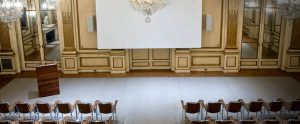Crossing Boundaries: Making World Art History
Session 3
Monday, September 26, 2016
10:00 am in the Lecture Hall
The Institute of Fine Arts is organizing a series of four workshops to be held at intervals in the spring and fall of 2016 for an invited group of curators and academics to exchange views about the shifting and expanded terrain of the art world and of art history. It can be argued that over the last 25 years museums have played a major role in challenging the western-dominated canon of modern and contemporary art. Exhibitions and catalogues have contributed largely to shaping the discourse of the global in art, while international biennials have vastly increased artists’ representation from Asia, the Middle East, Africa, Latin America, and the Caribbean. These projects are produced, however, within their own institutional frameworks and according to institutional priorities. As the familiar or traditional boundaries of art history are being redefined, this is a critical moment to cross those institutional boundaries in order to consider the consequences of the ways that “international contemporaneity” is being delineated according to emerging methodologies as well by unspoken and explicit assumptions. This dynamic moment in museum practice is matched by seismic shifts in how the chronologies and geographies of art history are being taught in the academy, creating an opportunity to assess how these emerging configurations are shaping historical understanding along with the pedagogy informing the coming generation of curators, teachers, and critics.
10:00 – 10:30 / Welcome and Introduction
10:30 – 11:45 / Panel 1: Border Crossings: Passage and Blockage
Borders are the outer limits of a given physical or conceptual space; they are usually considered in terms of the areas they define, rather than spaces or entities in their own right. In the age of Brexit, mass migration of refugees, right-wing campaigns for tightened border security, academic boycotts, and visa control, borders have become focal points in our contemporary zeitgeist. This inaugural panel of the fall series takes the title of this program as a more literal object of critique. Ever-changing border politics can complicate visa acquisition for traveling academics and artists, lead to internet and media censorship in certain countries, and threaten cultural artifacts in war-torn or environmentally-unstable regions: what happens when artists and artworks cross – or cannot cross – borders and boundaries? When the movement of people and objects is increasingly monitored and sanctioned, is global or world art possible?
11:45 – 12:15 / Break
12:15 – 1:30 / Panel 2: Linguistic Dissonance
Language plays a crucial role in accessibility: it can build bridges or barriers. Language exists in a multiplicity of forms and structures, each carrying a constellation of unique meanings and associations. When a word or concept is translated from one language to another, some of its contents are irretrievably lost. How can we minimize entropy while communicating across linguistically-diverse disciplinary communities? On the other hand, can linguistic inconvertibility, misperception, and nuance be productive?
Art historians are expected to be proficient in languages relevant to their areas of study. What are the benefits and limits of polylingual scholarship, and to what extent should it be put into practice? What is absent when scholars are not proficient in non-colonial languages such as kiSwahili, Yoruba, Nahuatl, Tamazight (Berber), or local dialects? Beyond the verbal, this panel might also consider alternative forms of communication: how can we record and preserve ephemera such as movement and gesture, modulation and tone?
1:30 – 2:30 / Lunch
2:30 – 3:45 / Panel 3: Area Focus: Expanding American Art
Is art history strengthened or attenuated by regional and geographic categories? How can the discipline adapt with shifting demographics, additive historical narratives, and geopolitical volatility? Can there exist a balance between global and local art histories?
The word “America” embodies such concerns in every sense of its use: as a name, identity, ideology, and place. We take this as a cogent opportunity to direct our focus to the evolution and plurality of America through an art historical lens. “America” is commonly used as a synonym of the United States: how might we benefit from a more complex, hemispheric understanding of America? How do we confront a discourse that has traditionally neglected the contributions of countless communities, such as First Nation, Latinx, African-American, Asian-American, and others? What are some challenges and limitations to expanding the scope of American art history, trans-historically and cross-culturally? What areas of expertise are – or should be – required of Americanist art historians and curators?
3:45 / Reception
Panelists
Caroline A. Jones, Professor, MIT
Gabriel Pérez-Barreiro, Director and Chief Curator, Colección Patricia Phelps de Cisneros
Irene Small, Assistant Professor, Princeton University
Rafal Niemojewski, Director, Biennial Foundation
André Lepecki, Associate Professor of Performance Studies, NYU Tisch
Joshua Cohen, Assistant Professor, The City College of New York
Reiko Tomii, Independent Art Historian, Critic, and Curator
Kathleen Ash-Milby, Associate Curator, National Museum of the American Indian
Donna De Salvo, Deputy Director for International Initiatives and Senior Curator, Whitney Museum of American Art
Yasmín Ramírez, Research Associate, Centro de Estudios Puertorriqueños at Hunter College
Joseph Roach, Professor of Theater and English / Director of Theater, Yale University


